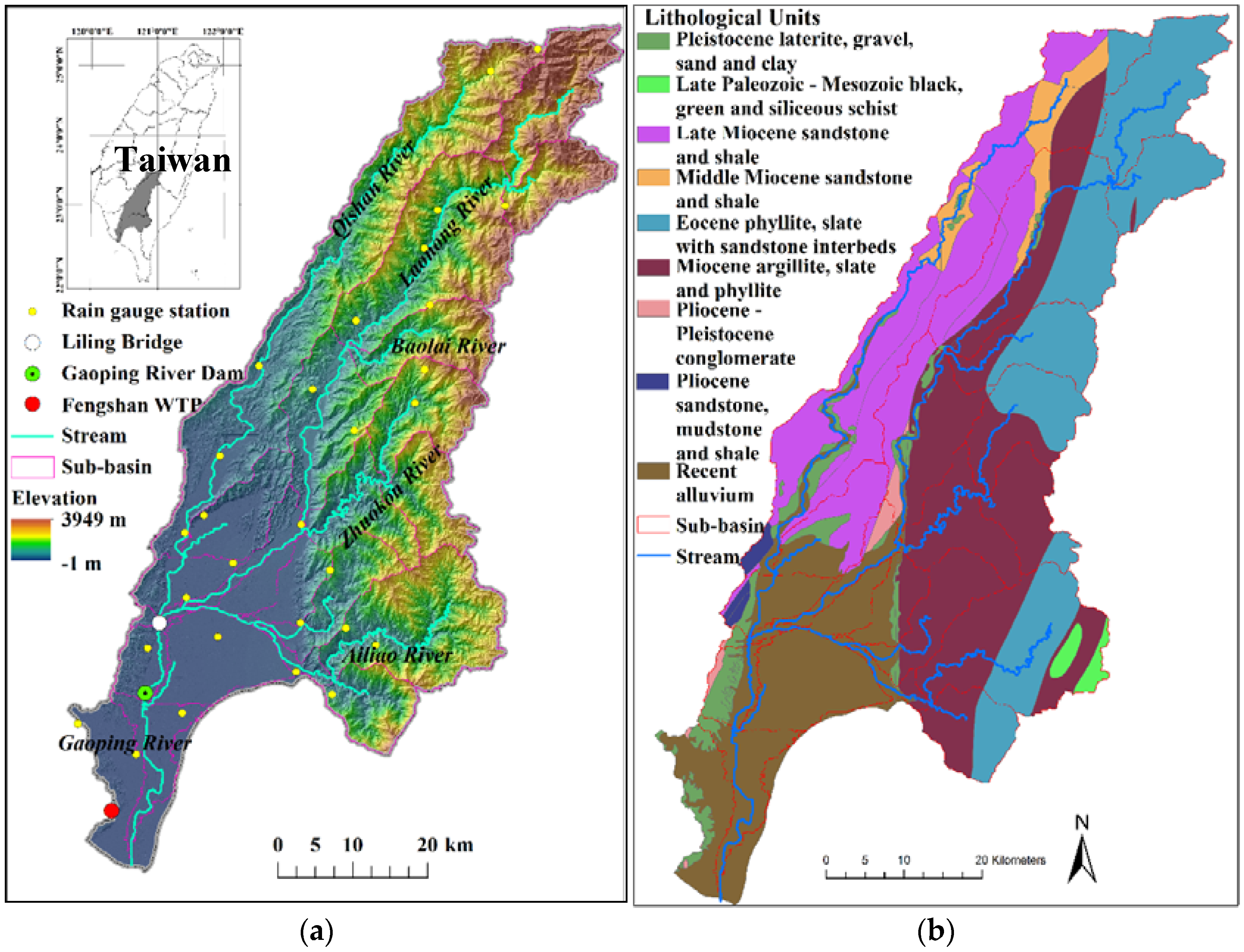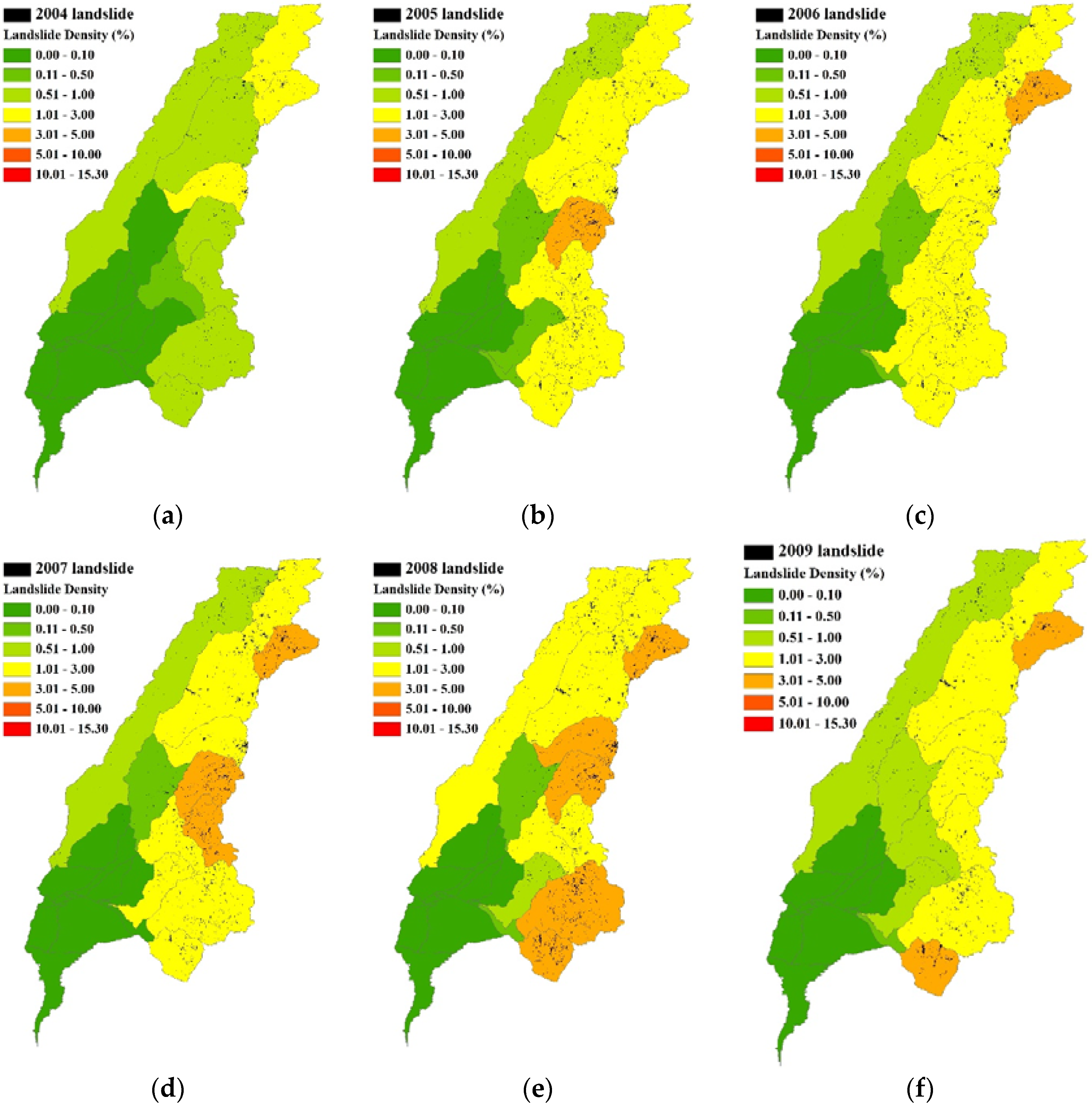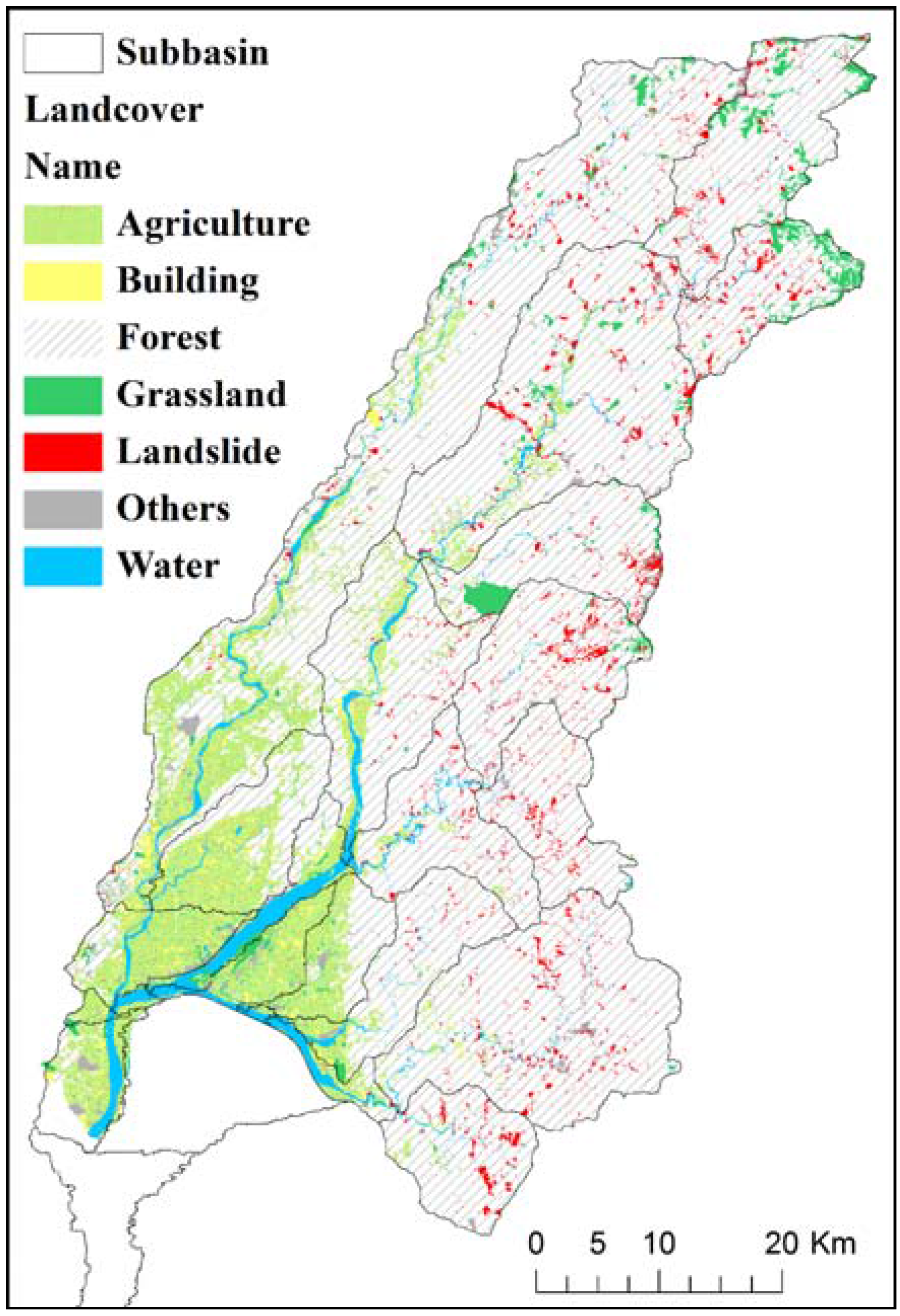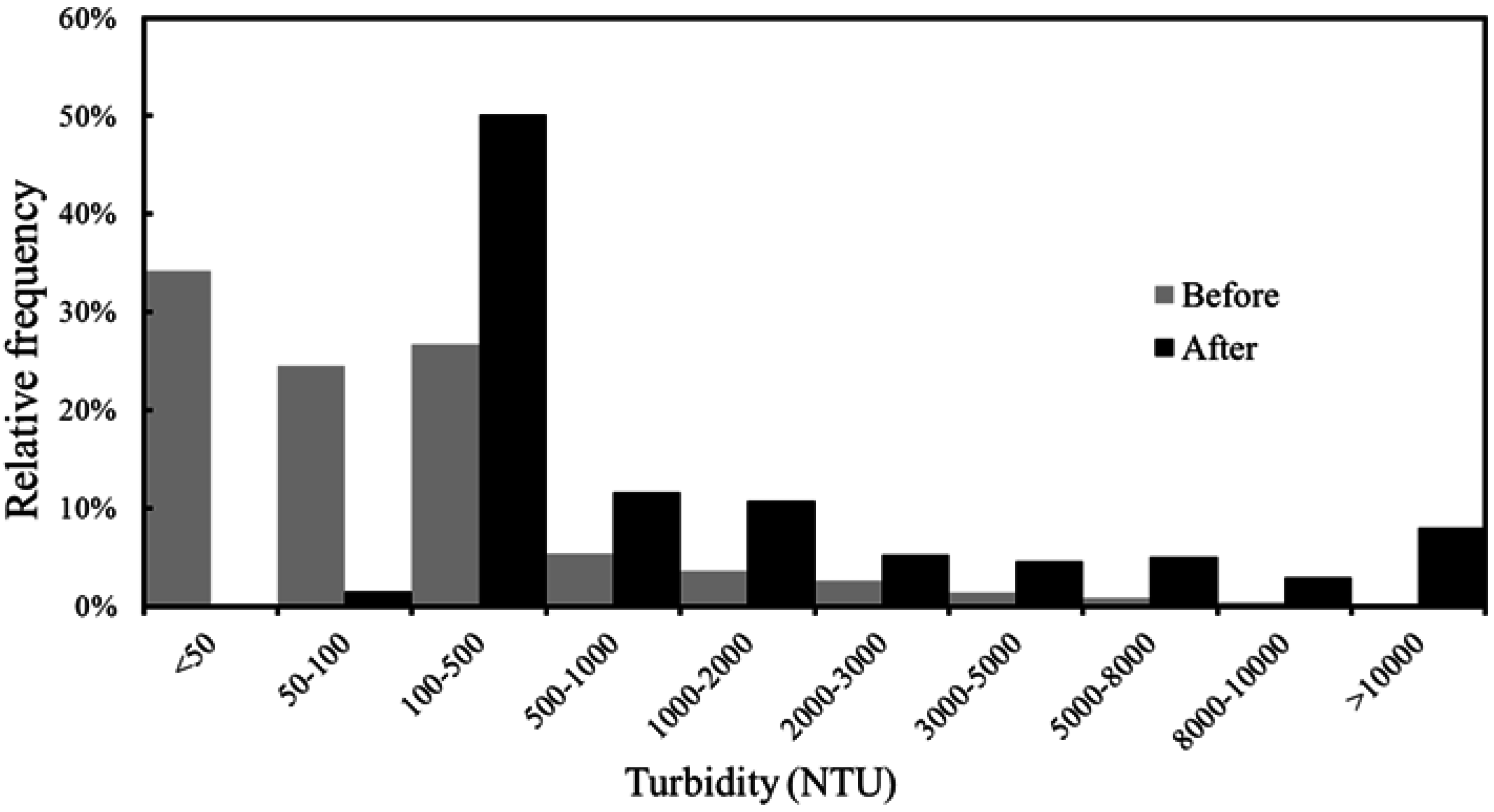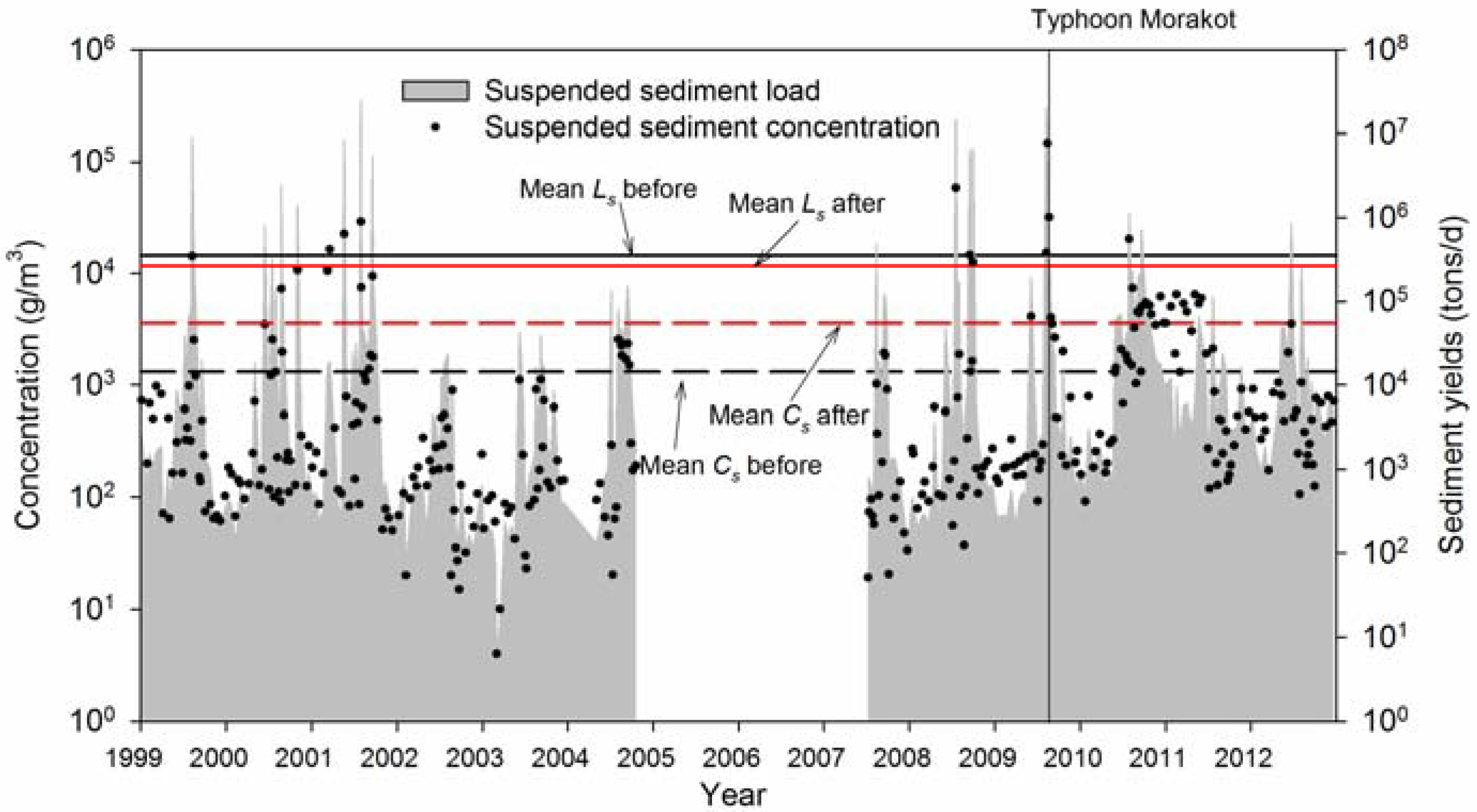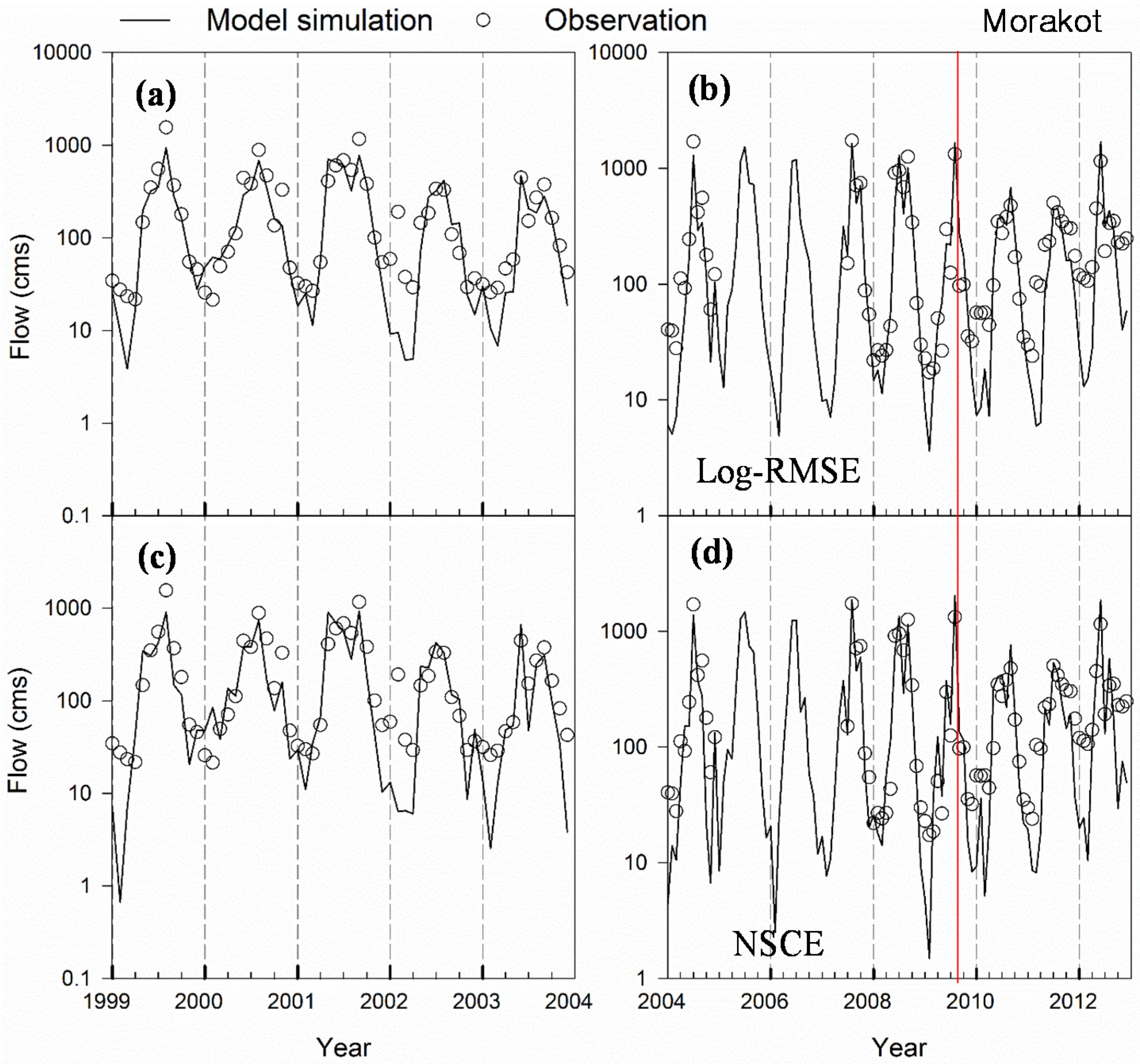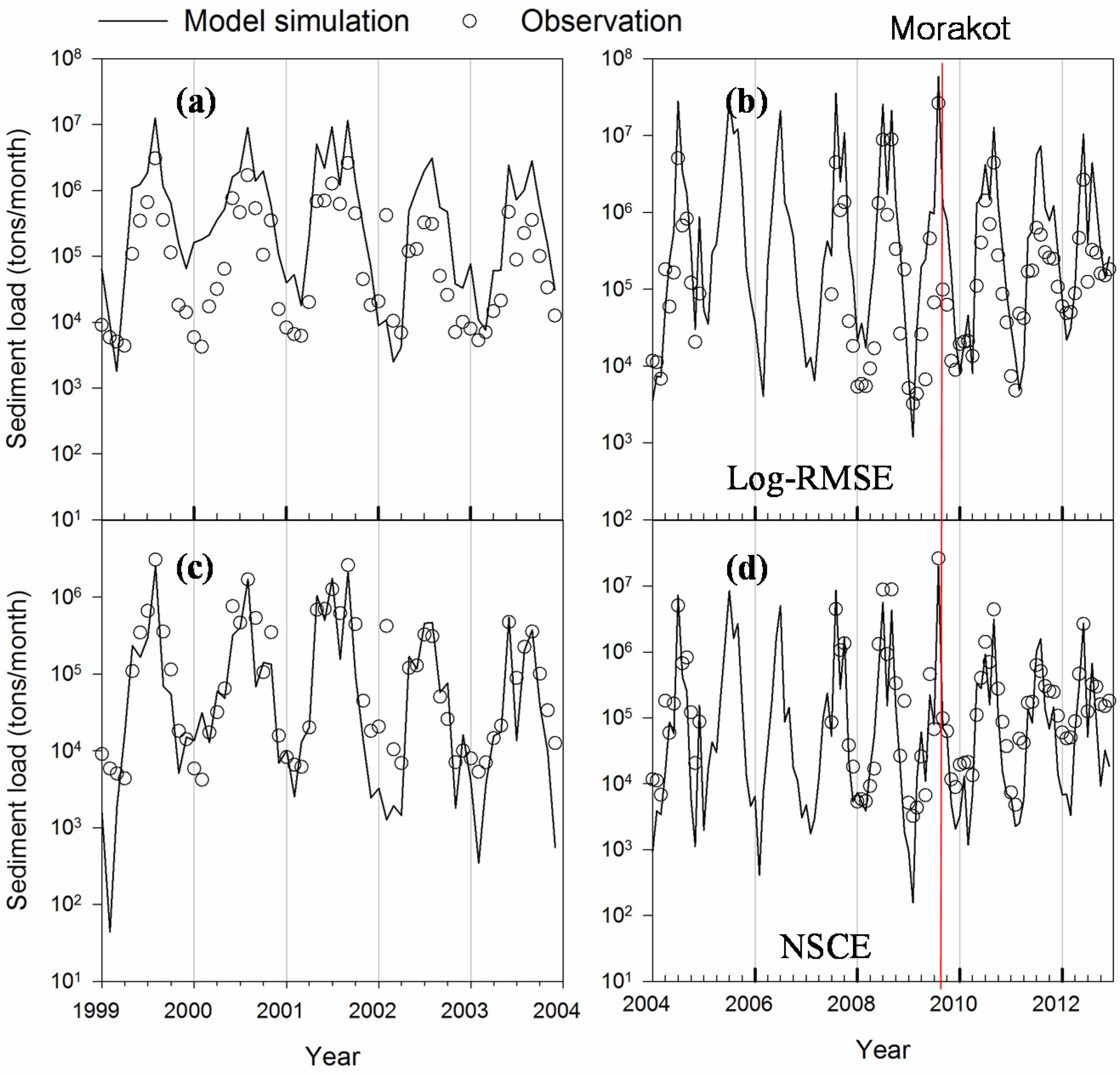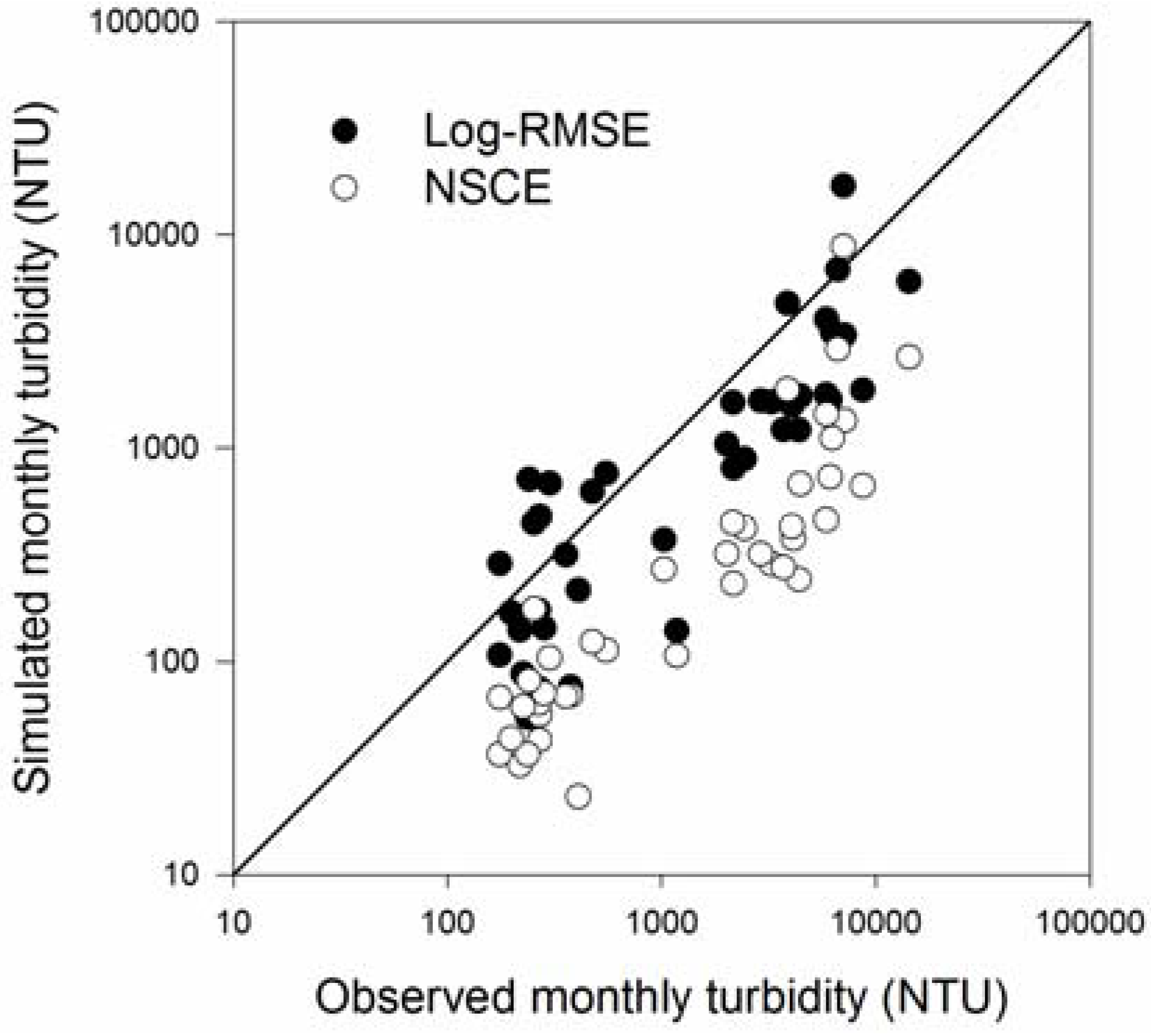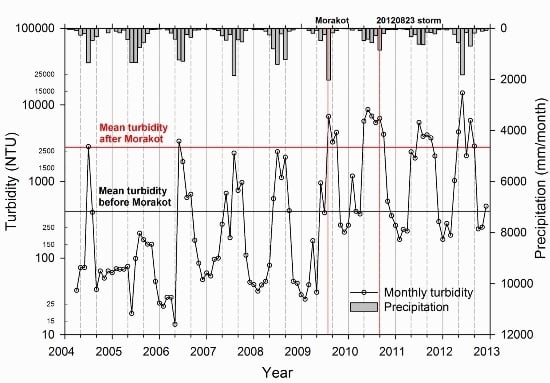1. Introduction
Landslides and sediment delivery processes in watersheds involve the uprooting of vegetation, degradation of riparian areas, alteration of drainage patterns and increase in the availability of erodible materials, all of which lead to enhanced soil erosion that causes downstream sediment issues. Taiwan is located in an active tectonic region, formed by the collision of the Luzon arc on the Philippine Sea plate and the Eurasian continental margin [
1]. Since Li (1976) [
2] reported a denudation rate claiming to be the highest in the world, issues related to hillslope erosion and sediment discharge in the Central Range of Taiwan have attracted widespread attention [
3]. Many studies have been performed to estimate the erosion rate and sediment discharge [
4], analyze factors controlling sediment removal and supply [
5,
6], identify the links between erosion, storm frequency and seismicity [
7], and investigate the roles of lithology, episodic events (typhoons and earthquakes) and human activities on sediment discharge [
3]. All show that frequent large earthquakes and typhoons triggered large numbers of landslides, which significantly modified the land cover patterns of mountain areas, resulting in high erosion rates and increased sediment fluxes to the ocean.
Landslides are the dominant mechanism of hillslope erosion in the Central Mountain Range of Taiwan [
5], the discharge from which is the primary source for the reservoirs and dams that meet public water supply needs. Landslides are thus considered as the most important factor influencing the level of suspended sediment concentration, sedimentation and turbidity in these water resources [
8]. Therefore, understanding watershed-scale hillslope erosion processes of landslides, sediment delivery and downstream responses is of importance to sustainable water management. However, due to the lack of systematic and comprehensive observations of landslides [
5], those erosional processes are most frequently studied in isolation [
9,
10] or in records of some extreme events [
8,
11]. The difficulty of obtaining a land-cover (LC) or a landslide map that coincides with the related discharge records is often a problem for the development of watershed-scale erosion and sediment transport models [
12]. Some studies thus assume that the LC is constant for a certain range of time [
13] or simulate the magnitude-frequency distribution of landslides by using various models [
5,
14]. However, simulated or modeled landslides often present an unreliable result with regard to the relationship between mass wasting and sediment yield. The remote sensing instrument onboard the Formosat-2 satellite, launched in 2004, was the first high-resolution optical sensor (2 m panchromatic and 8 m multispectral) in a daily revisit orbit of Taiwan. Compared to aerial photography [
15], the advantages of this system is the larger scene coverage and much higher revisit rate, which makes Formosat-2 imagery an ideal remote sensing data source to derive high quality LC maps with less cloud and shadow contamination. Additionally, with an archive from 2004 to the present date, Formosat-2 data can permit a one-decade assessment of mass wasting at a watershed-scale. Nine annual landslide maps for the study river basin were produced from Formosat-2 images taken each year from 2004 to 2012, followed by further interpretation by an expert system to delineate non-vegetated areas [
16].
With regard to the downstream water responses to upland landslides, previous studies have identified the formation of hyper-concentration flow or turbidity currents in rivers [
17], the occurrence of hyperpycnal flows [
18] and the associated high nephelometric turbidity in reservoirs [
8]. Among these downstream responses, the increased turbidity in rivers, which has both immediate and long-term adverse impacts on the public water supply, is the most important water quality issue associated with landslides in Taiwan. Peak turbidity inflow to a water treatment plant (WTP) that exceeds 10,000 NTU for an extended period of time may result in extended down time of water treatment facilities to carry out maintenance of fouled equipment, which, in turn, results in severe water service disruptions [
8,
19]. The long-term adverse impacts are dependent on the duration of the high-turbidity event and the turbidity baseline, which represents the non-disturbed status for individual catchments. In general, several days or weeks, depending on the intensity of disturbance, are required for sediment particles to gradually settle down and the turbidity to be restored to a baseline level [
20]. However, the erosional characteristics of the Gaoping River, the largest river in Taiwan in terms of the drainage area, appear to have been fundamentally altered by the rainstorm and landslide disturbances associated with Typhoon Morakot in 2009 [
21]. The following two changes occurred: (1) the probability of high-turbidity (>10,000 NTU) increased significantly after the disturbances; and (2) the turbidity has yet to return to a pre-Morakot baseline. These short- and long-term effects related to high turbidity have significantly increased the water-related stress in this area. However, the influence of landslides on these issues has rarely been examined in previous studies.
In this work, a total of nine annual land-use/land-cover (LULC) maps (2004 to 2012) of the Gaoping River Basin (GRB) were produced by overlapping each of the nine years’ Formosat-2 interpreted de-vegetative areas on the latest official LU map (2007), released by the National Land Surveying and Mapping Center (NLSC) of Taiwan. A modeling approach that integrates the LU update module of the Soil and Water Assessment Tool (SWAT) and two different types of objective functions for parameter calibration,
i.e., the log-scale root-mean-square-error (log-RMSE) and Nash-Sutcliffe Model Efficiency (NSCE) [
22], were used to analyze the impacts of upland landslides on downstream sediment yields and turbidity. Attention was given to examining the phenomenon of the rising turbidity/sediment load baseline in the Gaoping River after Typhoon Morakot. Using these observation data and modeling results, this study discusses three main issues including: (1) the impacts of Morakot-related disturbances on downstream water quality by assessing the changes in the relationships between river flow, rainfall intensity, sediment yields and turbidity; (2) quantifying the effects of landslides on annual sediment yields by comparing the SWAT modeling with and without the land-cover updating; and (3) simulating the increased turbidity baseline by moderating the calibration strategy of SWAT.
4. Conclusions and Summary
The catchment of Gaoping River is a Drinking Water Source Protection Area, where most human development activities are prohibited, and the most significant factors influencing upstream sediment erosion and transport are climatic and geomorphic processes. We determine that heavy rainfall and associated landsliding in the GRB influenced the water quality and water uses of the downstream river, particularly the level of suspended sediment and turbidity are primary concerns of the water supply.
Typhoon Morakot struck the GRB on 7 August 2009, bringing 1900 mm of rainfall in three days and triggering a 5.2% increase in landslide activity. The river system responded to these disturbances with extreme sediment erosion and transport, resulting in a significant water stoppage to over two million users. After the disturbances associated with Morakot, our study found that (1) turbidity was significantly altered; (2) the correlation between event rainfall and the resulting turbidity no longer existed; and (3) the rating-curve based relationship between sediment and discharge weakened significantly after Morakot. Surprisingly, the alterations in sediment transport are non-definitive because of the low annual precipitation from 2010 to 2012.
A SWAT model and two new simulation strategies were used to: (1) annually update the sub-basin with a landslide inventory map; and (2) calibrate the parameters with log-RMSE and NSCE objective functions; which used the observation data over the period 1999–2003 for the prediction of sediment load and turbidity during 2004–2012. This approach covers the river conditions before and after the typhoon induced alteration. In addition to the changed regression coefficient and exponent values of the
Cs-
Q rating curve that have been shown in a recent study [
21], in this work a number of related changes are further revealed, as follows: the one order of the magnitude increase in turbidity baseline; the larger
SPCON and
SPEXP values calibrated by the log-RMSE objective function; the lower occurrence of major rainfall events but increased frequency of high-turbidity; and the poor/altered relationship between cumulative rainfall and maximum daily turbidity in major high-turbidity events.
The strategy of landslide updating is carried out to improve the prediction of suspended sediment loads using a SWAT model. However, the modeling results also show that only adding the landslide ratio cannot fully address the deficit between the simulated and observed low-flow sediment discharges after Typhoon Morakot. The influence from the increased capacity of sediment that can be transported by the stream water is of significant concern. Therefore, this study recommends the use of log-RMSE calibrated parameters for the simulation of the altered suspended sediment and turbidity regime after Typhoon Morakot.
The landslide ratio decreased 2% during 2010–2012, due to the rapid growth of natural vegetation and engineered restoration methods. However, if the change in sediment transport is intrinsic, the increased turbidity baseline will likely not return to pre-Morakot levels, even after all related landslides are recovered.
